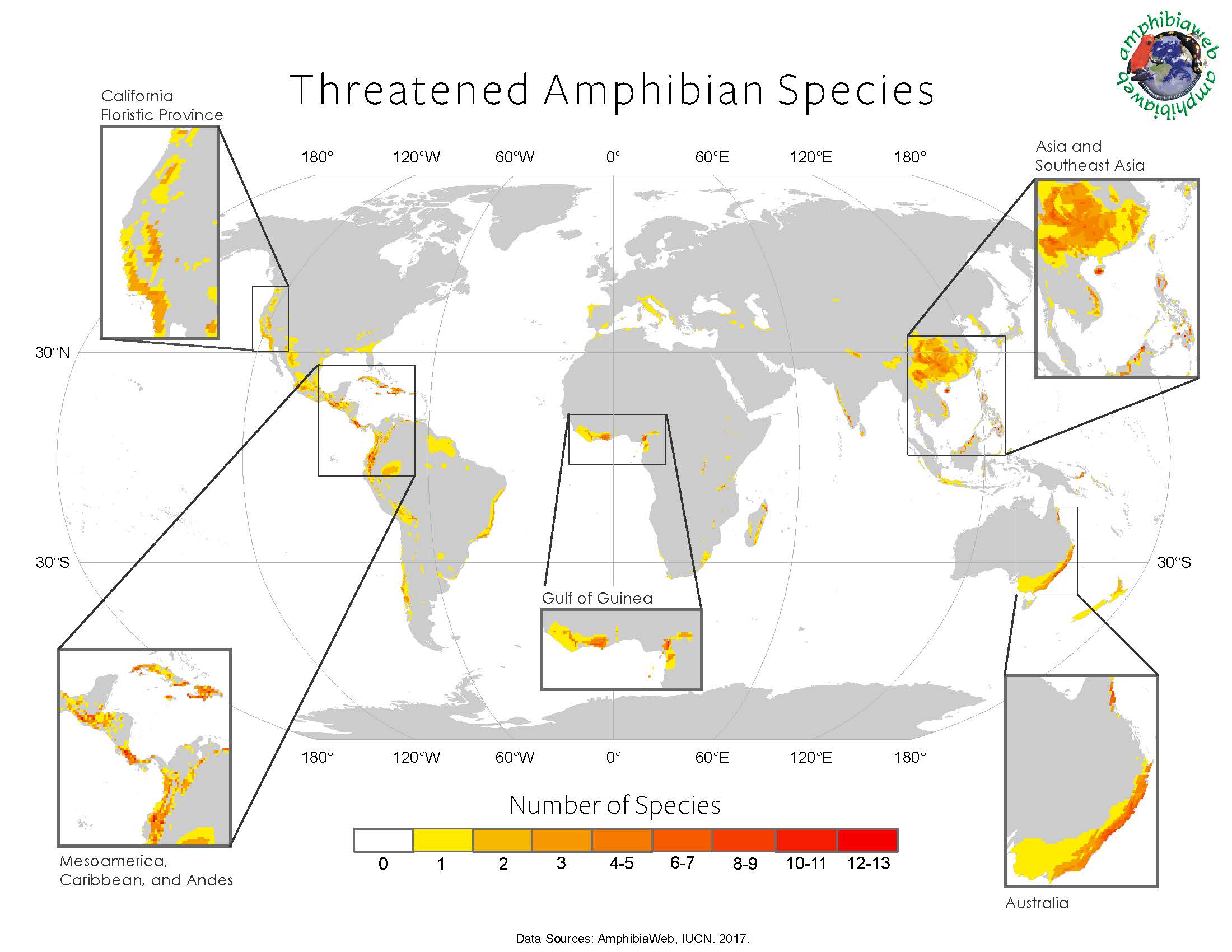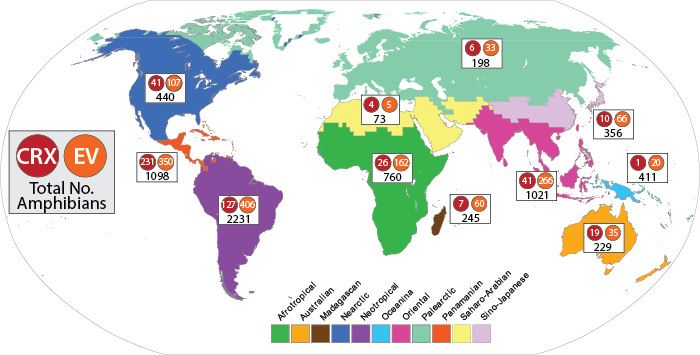Worldwide Amphibian Declines:
What is the scope of the problem, what are the causes, and what can be done?
February 13, 2013
Updated March 3, 2017
Amphibian Declines:
- Introduction
- Maps of Global Declines
- Why are Populations Declining?
- Factors Involved in Amphibian Decline
- Solutions
- Literature Cited
- Recent Scientific Publications (updated MONTHLY)
I. Introduction
Amphibians, a unique group of vertebrates containing over 7,000 known species, are threatened worldwide. A 2004 global assessment (Baillie et al (eds) 2004) found that nearly one-third (32%) of the world's amphibians are threatened, representing 1,856 species. Amphibians have existed on earth for over 300 million years, yet in just the last two decades there have been an alarming number of extinctions, nearly 168 species are believed to have gone extinct and at least 2,469 (43%) more have populations that are declining. This indicates that the number of extinct and threatened species will probably continue to rise (Stuart et al. 2004).
II. Maps of Global Declines
A global map of threatened species highlights where the most vulnerable and endangered species are concentrated. There are now threatened hotspots on every continent, with particularly alarming increases in the western North America in the California Floristic Province, Mesoamerica and the Caribbean, western Africa in the Gulf of Guinea, Asia and Southeast Asia and southeastern Australia.

Read more about our methods including a list of threatened species.
Download the map as pdf here.
Threatened and Endangered species by Wallacean Biome

Download a pdf version here.
Numbers of Critically Endangered and Vulnerable species have increased worldwide as quantified in this map colored by biogeographic biomes defined by Wallace and redefined by Holt et al (2012 in Science).
The tallies of species are: 1) In red: Number of Extinct, Extinct in the wild or Critically Endangered species; 2) In orange, Number of Endangered or Vulnerable species; 3) In white, Total number of species within a biome. Download the map as pdf here. Contact AmphibiaWeb to learn more.
III. Why Are Amphibian Populations Declining?
Clearly, the most important factor leading to amphibian population declines is habitat destruction. When forests are cleared it is no surprise that species that once lived there disappear. What is alarming is that there are many cases where the habitat is protected and amphibians are still disappearing. The causes for recent amphibian declines are many, but an emerging disease called chytridiomycosis and global climate change are thought the be the biggest threats to amphibians. Chytridiomycosis is a disease caused by the fungal chytrid pathogen Batrachochytrium dendrobatidis. This pathogen is associated with the global loss of hundreds of species of amphibians and represents a spectacular loss of biodiversity, some say the worst in recorded history.
In the table below, we break down all of the hypothesized factors and the links provide more detailed information for each one. Some factors are obviously shared with other types of endangered species on our planet and are part of to the worldwide biodiversity crisis such as habitat destruction, alteration and fragmentation (Fisher and Shaffer 1996, Davidson et al. 2001, Marsh and Trenham 2001), introduced species (Vredenburg 2004, Kats and Ferrer 2003) and over-exploitation (Jennings and Hayes 1985, Lannoo et al. 1994). For these threats, we have a pretty good understanding of the ecological mechanisms underlying declines (Collins and Storfer 2003). However, amphibians have also declined in relatively "pristine" and protected environments (Wake 1991, Crump et al. 1992, Lips 2000). These more complex and elusive mechanisms include climate change (Pounds et al. 1999, Kiesecker et al. 2001, Carey and Alexander 2003), increased UV-B radiation, chemical contaminants (Hayes et al. 2002, Blaustein et al. 2003), emerging infectious diseases (Daszak et al. 2003; see AmphibiaWeb's global distribution map of chytrid) and deformities (or malformations). The underlying mechanisms behind these factors are complex and they may be working synergistically with more straight forward factors, such as habitat destruction and introduced species, to exacerbate declines (Kiesecker et al. 2001, Blaustein and Kiesecker 2002). Researchers are finding that there is not a single overarching cause for global declines, instead all of these factors are threatening amphibian populations and the threat tends to vary depending on the location. If we are going to prevent further extinctions, research must move forward quickly and be used effectively in management by governments and non-governmental organizations around the world.
IV. Factors Involved in Amphibian Declines
Table 1. Probable and confirmed factors causing amphibian declines (modified from Table 1 in Young et al. 2001). See Blue Tabs on sidebar to Decline Factors, which are linked in table below.
| FACTOR | PROCESS(ES) |
| Habitat destruction, alteration and Fragmentation | Roads, introduced species, or other factors separate remaining populations of amphibians from each other. |
| Introduced Species | Non-native species prey on or compete with native amphibians. |
| Over-Exploitation | Amphibians are removed form the wild and sold internationally as food, as pets, or for medicinal and biological supply markets |
| Climate Change | Amphibians are extremely sensitive to small changes in temperature and moisture. Changes in global weather patterns (e.g. El Nino events or global warming) can alter breeding behavior, affect reproductive success, decrease immune functions and increase amphibian sensitivity to chemical contaminants. |
| UV-B Radiation | Levels of UV-B radiation in the atmosphere have risen significantly over the past few decades. Researchers have found that UV-B radiation can kill amphibians directly, cause sublethal effects such as slowed growth rates and immune dysfunction, and work synergistically with contaminants, pathogens and climate change. |
| Chemical Contaminants | Chemical stressors (e.g., pesticides, heavy metals, acidification and nitrogen based fertilizers) can have lethal, sublethal, direct or indirect effects on amphibians. These effects may include death, decreased growth rates, developmental and behavioral abnormalities, decreased reproductive success, weakened immune systems and/or hermaphroditism. |
| Disease | Diseases (such as chytridiomycosis) or increased susceptibility to existing diseases leads to deaths of adults and larvae. New chytrid diseases such as those caused by Batrachochytrium salamandrivorans seem to be particularly lethal to salamanders. |
| Deformities | There has been a recent and widespread increase of deformities (or malformations) in natural populations of amphibians; this is now perceived as a major environmental problem. |
| Synergisms | Multiple factors can act together to cause mortality or sublethal effects. |
V. WHAT CAN BE DONE TO SAVE AMPHIBIANS?
There are solutions to the sharp declines of amphibian species around the world!
Hear Kevin Zippel detail examples in The Role of Zoos.
Visit our Solutions page to learn more about the types of conservation efforts around the world. What about combatting amphibian disease with a vaccine? See a video on just such research in Deep Look by KQED on our Solutions page.
To combat the deadly chytrid fungus, some researchers are exploring the role of the epidermal microbial flora with some successes in fending off chytridiomycosis in frogs. Read more about the Amphibian Microbiome.
Check out other amphibian conservation organizations!
VI. Literature Cited
Alford, R. A., and S. J. Richards. 1999. Global amphibian declines: A problem in applied ecology. Pages 133-165 in Annual Review of Ecology and Systematics. Annual Reviews, Palo Alto.
Blaustein, A. R., and J. M. Kiesecker. 2002. Complexity in conservation: Lessons from the global decline of amphibian populations. Ecology Letters 5:597-608.
Blaustein, A. R., J. M. Romansic, J. M. Kiesecker, and A. C. Hatch. 2003. Ultraviolet radiation, toxic chemicals and amphibian population declines. Diversity & Distributions [print] 9:123-140.
Blaustein, A. R., and D. B. Wake. 1990. Declining amphibian populations - a global phenomenon. Trends in Ecology & Evolution 5:203-204.
Carey, C., and M. A. Alexander. 2003. Climate change and amphibian declines: is there a link? Diversity and Distributions 9:111-121.
Collins, J. P., and A. Storfer. 2003. Global amphibian declines: Sorting the hypotheses. Diversity & Distributions [print] 9:89-98.
Crump, M. L., F. R. Hensley, and K. L. Clark. 1992. Apparent decline of the Golden Toad: underground or extinct? Copeia 1992:413-420.
Daszak, P., A. A. Cunningham, and A. D. Hyatt. 2003. Infectious disease and amphibian population declines. Diversity & Distributions [print] 9:141-150.
Davidson, C., H. B. Shaffer, and M. R. Jennings. 2001. Declines of the California red-legged frog: Climate, UV-B, habitat, and pesticides hypotheses. Ecological Applications 11:464-479.
Fisher, R. N., and H. B. Shaffer. 1996. The decline of amphibians in California's Great Central Valley. Conservation Biology 10:1387-1397.
Hayes, T. B., A. Collins, M. Lee, M. Mendoza, N. Noriega, A. A. Stuart, and A. Vonk. 2002. Hermaphroditic, demasculinized frogs after exposure to the herbicide atrazine at low ecologically relevant doses. Proceedings of the National Academy of Sciences of the United States of America 99:5476-5480.
Houlahan, J. E., C. S. Findlay, B. R. Schmidt, A. H. Meyer, and S. L. Kuzmin. 2000. Quantitative evidence for global amphibian population declines. Nature 404:752-755.
Jennings, M. R., and M. P. Hayes. 1985. Pre-1900 overharvest of California [USA] red-legged frogs (Rana aurora draytonii): The inducement for bullfrog (Rana catesbeiana) introduction. Herpetologica 41:94-103.
Kats, L. B., and R. P. Ferrer. 2003. Alien predators and amphibian declines: Review of two decades of science and the transition to conservation. Diversity & Distributions [print] 9:99-110.
Kiesecker, J. M., A. R. Blaustein, and L. K. Belden. 2001. Complex causes of amphibian population declines. Nature 410:681-684.
Lannoo, M. J., K. Lang, T. Waltz, and G. S. Phillips. 1994. An altered amphibian assemblage: Dickinson County, Iowa, 70 years after Frank Blanchard's survey. American Midland Naturalist 131:311-319.
Lips, K. R. 2000. Decline of a tropical amphibian fauna. in 166th National Meeting of the American Association for the Advancement of Science (AAAS) and Science Innovation Exposition., Washington, D.C., USA, February 17-22, 2000.
Marsh, D. M., and P. C. Trenham. 2001. Metapopulation dynamics and amphibian conservation. Conservation Biology 15:40-49.
Pounds, A., M. Fogden, and J. Campbell. 1999. Biological response to climate change on a tropical mountain. Nature 398:611-614.
Stuart, S., Chanson, J. S., Cox, N. A., Young, B. E., Rodrigues, A. S. L., Fishman, D. L. and Waller, R. W. 2004. Status and trends of amphibian declines and extinctions worldwide. - Science 306: 1783-1786.
Vredenburg, V. T. 2004. Reversing introduced species effects: Experimental removal of introduced fish leads to rapid recovery of declining frog. Proceedings of the National Academy of Sciences 101(20):7646-7650.
Wake, D. B. 1991. Declining amphibian populations. Science 253:860.
Young, B. E., K. R. Lips, J. K. Reaser, R. Ibanez, A. W. Salas, J. R. Cedeno, L. A. Coloma, S. Ron, E. La Marca, J. R. Meyer, A. Munoz, F. Bolanos, G. Chaves, and D. Romo. 2001. Population declines and priorities for amphibian conservation in Latin America. Conservation Biology 15:1213-1223.
Literature citations edited by John Wilkinson (johnjwilkinson at hotmail), May 14, 2008.
VII. Recent Scientific Publications
AmphibiaWeb maintains a list of recent scientific publications on amphibian declines and amphibian conservation.This list is compiled and updated monthly by Professor Tim Halliday (formerly DAPTF International Director) (t.r.halliday@open.ac.uk).

